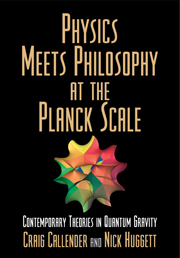Book contents
- Frontmatter
- Contents
- Preface
- 1 Introduction
- Part I Theories of Quantum Gravity and their Philosophical Dimensions
- Part II Strings
- 5 Reflections on the fate of spacetime
- 6 A philosopher looks at string theory
- 7 Black holes, dumb holes, and entropy
- Part III Topological Quantum Field Theory
- Part IV Quantum Gravity and the Interpretation of General Relativity
- Part V Quantum Gravity and the Interpretation of Quantum Mechanics
- References
- Notes on contributors
- Index
7 - Black holes, dumb holes, and entropy
Published online by Cambridge University Press: 15 December 2009
- Frontmatter
- Contents
- Preface
- 1 Introduction
- Part I Theories of Quantum Gravity and their Philosophical Dimensions
- Part II Strings
- 5 Reflections on the fate of spacetime
- 6 A philosopher looks at string theory
- 7 Black holes, dumb holes, and entropy
- Part III Topological Quantum Field Theory
- Part IV Quantum Gravity and the Interpretation of General Relativity
- Part V Quantum Gravity and the Interpretation of Quantum Mechanics
- References
- Notes on contributors
- Index
Summary
It has now been 25 years since Hawking (Hawking 1974, 1975, Bardeen, Carter, and Hawking 1973) first surprised the world of physics with his analysis of quantum fields near black holes. Black holes, as their name implies, were believed to be objects into which things could fall, but out of which nothing could come. They were the epitome of black and dark objects. However, Hawking's analysis predicted that black holes should radiate, the radiation should be continuous and thermal, and the temperature should be inversely proportional to the mass of the black hole. Since black holes can also be said to have an energy proportional to their mass, this result led to opening of a whole new field of black hole thermodynamics.
That black holes could behave like thermodynamic objects had been intimated by results over the the previous five years. Christodolou (1970), Hawking and Ellis (1973, especially Lemma 9.2.2), Misner, Thorne, and Wheeler (1973) and Bekenstein (1973, 1974) had shown that there were certain formal similarities between black holes and thermodynamic objects. In particular, if one assumed positive energy for matter (an uncontested assumption), then – as Hawking most clearly showed – the area of a black hole horizon does not decrease. However, this formal similarity with entropy, which also does not decrease for an isolated system, did not seem to have any real relation with thermodynamics. The entropy of a body does not decrease only if the body is isolated, and not in interaction with any other system.
- Type
- Chapter
- Information
- Physics Meets Philosophy at the Planck ScaleContemporary Theories in Quantum Gravity, pp. 152 - 174Publisher: Cambridge University PressPrint publication year: 2001
- 9
- Cited by

